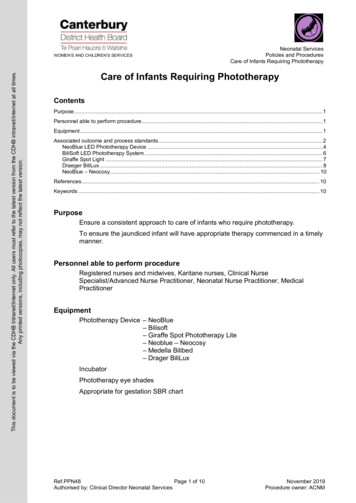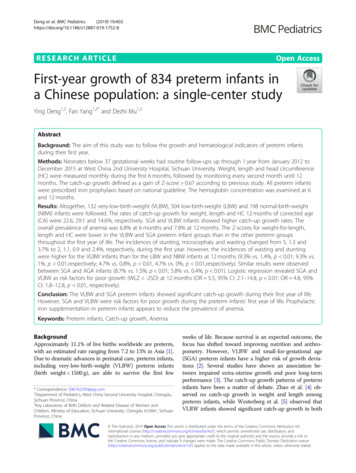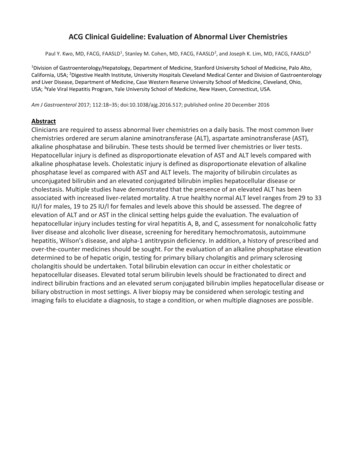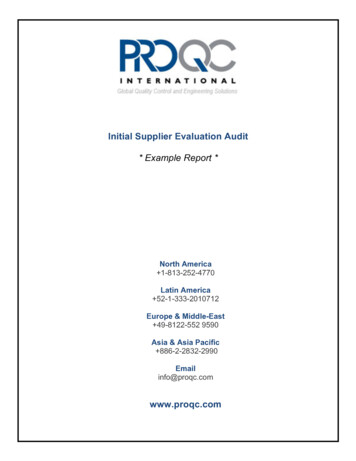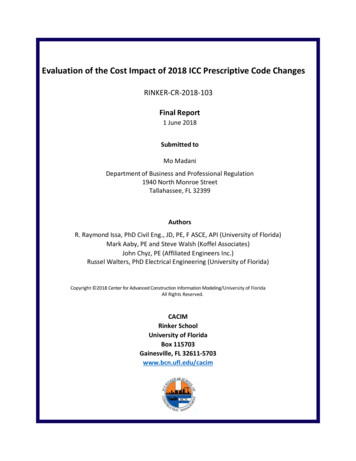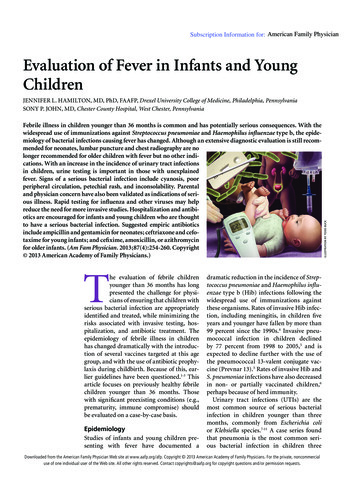
Transcription
Subscription Information for: American Family PhysicianEvaluation of Fever in Infants and YoungChildrenFebrile illness in children younger than 36 months is common and has potentially serious consequences. With thewidespread use of immunizations against Streptococcus pneumoniae and Haemophilus influenzae type b, the epidemiology of bacterial infections causing fever has changed. Although an extensive diagnostic evaluation is still recommended for neonates, lumbar puncture and chest radiography are nolonger recommended for older children with fever but no other indications. With an increase in the incidence of urinary tract infectionsin children, urine testing is important in those with unexplainedfever. Signs of a serious bacterial infection include cyanosis, poorperipheral circulation, petechial rash, and inconsolability. Parentaland physician concern have also been validated as indications of serious illness. Rapid testing for influenza and other viruses may helpreduce the need for more invasive studies. Hospitalization and antibiotics are encouraged for infants and young children who are thoughtto have a serious bacterial infection. Suggested empiric antibioticsinclude ampicillin and gentamicin for neonates; ceftriaxone and cefotaxime for young infants; and cefixime, amoxicillin, or azithromycinfor older infants. (Am Fam Physician. 2013;87(4):254-260. Copyright 2013 American Academy of Family Physicians.)The evaluation of febrile childrenyounger than 36 months has longpresented the challenge for physicians of ensuring that children withserious bacterial infection are appropriatelyidentified and treated, while minimizing therisks associated with invasive testing, hospitalization, and antibiotic treatment. Theepidemiology of febrile illness in childrenhas changed dramatically with the introduction of several vaccines targeted at this agegroup, and with the use of antibiotic prophylaxis during childbirth. Because of this, earlier guidelines have been questioned.1-3 Thisarticle focuses on previously healthy febrilechildren younger than 36 months. Thosewith significant preexisting conditions (e.g.,prematurity, immune compromise) shouldbe evaluated on a case-by-case basis.EpidemiologyStudies of infants and young children presenting with fever have documented adramatic reduction in the incidence of Streptococcus pneumoniae and Haemophilus influenzae type b (Hib) infections following thewidespread use of immunizations againstthese organisms. Rates of invasive Hib infection, including meningitis, in children fiveyears and younger have fallen by more than99 percent since the 1990s.4 Invasive pneumococcal infection in children declinedby 77 percent from 1998 to 2005,5 and isexpected to decline further with the use ofthe pneumococcal 13-valent conjugate vaccine (Prevnar 13).5 Rates of invasive Hib andS. pneumoniae infections have also decreasedin non- or partially vaccinated children,6perhaps because of herd immunity.Urinary tract infections (UTIs) are themost common source of serious bacterialinfection in children younger than threemonths, commonly from Escherichia colior Klebsiella species.7-11 A case series foundthat pneumonia is the most common serious bacterial infection in children threeDownloaded from the American Family Physician Web site at www.aafp.org/afp. Copyright 2013 American Academy of Family Physicians. For the private, noncommercial254 mber4 Februaryuse of oneFamilyindividualuser of the Web site. All other rights reserved.Contact copyrights@aafp.org for copyrightquestionspermissionrequests. 15, 2013 ILLUSTRATION BY TODD BUCKJENNIFER L. HAMILTON, MD, PhD, FAAFP, Drexel University College of Medicine, Philadelphia, PennsylvaniaSONY P. JOHN, MD, Chester County Hospital, West Chester, Pennsylvania
Childhood Feverto 36 months of age, followed by UTI.12 A large studyfound that the rate of hospitalization for UTI, includingpyelonephritis and urosepsis, in children younger than12 months has notably increased.13 This increase coincides with an increase in E. coli and other infections thatare resistant to penicillin and ampicillin.9,14 The cause forthis shift in infection and resistance patterns is not clear.Clinically Significant FeverA clinically significant fever in children younger than36 months is a rectal temperature of at least 100.4 F(38 C). Axillary, tympanic, and temporal artery measurements have been shown to be unreliable.15-18 Neonateswhose parents report a clinically significant fever mayhave a serious bacterial infection, even if they do not havea fever at the time of their initial medical evaluation.19Age StratificationTraditionally, guidelines for the management of feverin children have been based on age groups: neonates(younger than 30 days2 or 28 days7,20); young infants (upto two months21-23 or three months11,20,24-26); and olderinfants and young children (up to 36 months). Theprecise boundaries delineating these groups are underreview.27 Evidence supporting the use of particular ageranges, especially in children not vaccinated accordingto the recommended schedule, is limited.immunodeficiency virus infection) need more extensiveevaluation and treatment. Conversely, findings that suggest a benign cause for fever, such as vaccination in thepast 24 hours, are reassuring.10 Teething is rarely associated with a fever of more than 100.4 F28 ; therefore,teething should not prevent a thorough examination in ayoung child with a fever.A meta-analysis of febrile children older than onemonth has identified red flags associated with a highlikelihood of serious infection (Table 1).29 The studyidentified no findings with a negative likelihood ratio ofless than 0.1, which would help distinguish children atlow risk of serious infection.Laboratory Testing and ImagingHistory and physical examination cannot identify allchildren with serious bacterial infections; therefore, judicious use of imaging and laboratory testing is valuable.URINALYSIS AND URINE CULTUREBecause UTI is a common cause of serious bacterialinfection, urinalysis is a key factor in the evaluation offever in infancy and early childhood. Although this testis often omitted because of the difficulty with obtaining a specimen, a clinically valid urine sample shouldbe obtained for all children younger than 24 monthswith unexplained fever.30 The sample may be obtainedby catheterization or suprapubic aspiration. In childrenHistory and Physical Examinationwith voluntary urine control, a clean catch method (uriInitial history and physical examination in infants and nation into a specimen container after cleaning the areayoung children with fever is directed at recognition of around the urethra) may be used. Cultures of specimensserious illness. Children known to be immunocom- collected in a urine bag may have an 85 percent falsepromised (e.g., those with cancer, asplenia, or human positive rate,30 and urine dipstick testing has a 12 percentfalse-negative rate.31 All specimens shouldbe sent for formal urinalysis and culture.Table 1. Clinical Red Flags for Serious Infection in ChildrenUTI rates vary with patient sex and age. InOlder than One Monththe first three months of life, UTIs are morecommon in boys than in girls, and muchGlobal assessmentsCirculatory/respiratoryOther factorsmore common in uncircumcised boys. AfterParental concernsCracklesDecreased skinthree months of age, UTIs are more commonelasticityPhysician instinctCyanosisin girls.32Child behaviorChanges in ased breathsoundsPoor peripheralcirculationRapid breathingShortness of breathHypotensionMeningealirritationPetechial rashSeizuresUnconsciousnessThese red flags are associated with a positive likelihood ratio of greater than 5for serious infection in this population.NOTE:Information from reference 29.February 15, 2013 Volume 87, Number 4www.aafp.org/afp BLOOD CELL COUNTS AND BLOOD CULTUREWhite blood cell (WBC) counts and absoluteneutrophil counts have been used to identifyserious bacterial infection, including occultbacteremia. However, recent studies question their utility after early infancy.6,12,33,34Although various suggested cutoff values forthese tests have high sensitivity and reasonably high specificity, the rarity of bacteremiaAmerican Family Physician 255
Childhood Feverin this population leads to a low positive predictive value(PPV). For example, the presence of an absolute neutrophil count of 15,000 per mm3 (15 109 per L) has a PPVof only 11 percent.6 Blood cell counts have higher utility in neonates than in older children.8,22 In a study ofneonates up to 28 days of age, a WBC count lower than5,000 per mm3 (5 109 per L) or more than 15,000 permm3 (15 109 per L) had a PPV of 44 percent for seriousbacterial infection, and an absolute neutrophil count ofmore than 10,000 per mm3 (10 109 per L) had a PPV of71 percent.8Current guidelines recommend a complete bloodcount with differential and blood culture for infantsthree months or younger with fever.35,36 However, someexperts recommend a more selective approach in infantsolder than 28 days, limiting laboratory testing to thosewith clinical signs of serious infection.1,2STOOL TESTINGIn neonates and young infants, diarrhea with fever suggests a systemic illness, and therefore stool culture andfecal WBC counts are recommended.27,36,37 There arefew studies that suggest the need for stool testing in theabsence of a localizing sign, such as diarrhea.INFLAMMATORY MARKERSThe clinical utility of C-reactive protein levels in recognizing serious infection in neonates, infants, andyoung children is being explored.7,8,11,38 Initial studiesindicate that a C-reactive protein level of 2 mg per dL(19 nmol per L) or greater has better sensitivity, specificity, and predictive value than a WBC count of greaterthan 15,000 per mm3 or less than 5,000 per mm3.11 AC-reactive protein cutoff value as high as 50 mg per dL(476.2 nmol per L) is also being investigated.39Elevated levels of procalcitonin, another marker ofinflammation and bacterial infection, also appear tohave better sensitivity, specificity, and predictive valuethan WBC counts.40 The theoretical advantages of procalcitonin testing must be balanced against its highercost, reduced availability, and delay in the availabilityof results.1 Moreover, it is unclear whether procalcitonintest results affect clinical decisions to administer antibiotics or hospitalize febrile children.41LUMBAR PUNCTUREThe success of infant vaccination for S. pneumoniae andHib has greatly reduced the incidence of meningitis,4,5limiting the indications for lumbar puncture. The test isrecommended for all febrile neonates,7,42 and for infantsand young children with clinical signs of meningitis,256 American Family Physiciansuch as nuchal rigidity, petechiae, or abnormal neurologic findings.2,42Lumbar puncture is not recommended for childrenolder than three months unless neurologic signs are present.2,42 The indications for lumbar puncture in younginfants (one to three months of age) are under examination. Research suggests that the test is not needed for allfebrile infants in this age group,12,42 but there is no consensus on appropriate indications.2,36,43 Two guidelinessuggest that a lumbar puncture may be omitted for wellappearing, previously healthy young infants with no focalsigns of infection, a WBC count between 5,000 and 15,000per mm3, and no pyuria or bacteriuria on urinalysis.35,43Although low peripheral WBC counts (less than 5,000per mm3) are more often associated with meningitis thanwith bacteremia,44 WBC counts should not be used aloneto determine which infants need lumbar puncture. Useof a threshold WBC count of less than 5,000 per mm3would miss 2.1 cases of meningitis for each one detected,and a WBC count of more than 15,000 per mm3 wouldmiss 2.7 cases for each one detected.45IMAGINGChest radiography may be performed in all neonateswith unexplained fever, although supporting evidenceis limited.46,47 Chest radiography is also recommendedfor young children older than one month demonstrating respiratory symptoms,36 and for those with a feverof more than 102.2 F (39 C) and a WBC count of morethan 20,000 per mm3 (20 109 per L).47HERPES SIMPLEX VIRAL TESTINGAlthough herpes simplex virus infection in neonatesis uncommon (25 to 50 cases per 100,000 live births inthe United States48,49), the prevalence of the infectionin febrile neonates is similar to that of bacterial meningitis.48 Risk factors include invasive monitoring during delivery,49 seizures, cerebrospinal fluid pleocytosis,and the presence of lesions.27 Birth by cesarean deliveryis somewhat protective against transmission of herpessimplex virus.49 Detection of herpes simplex virus DNAin cerebrospinal fluid via polymerase chain reaction isdiagnostic.50 Use of high-dose intravenous acyclovir,60 mg per kg per day in three divided doses, has beenshown to improve outcomes.51RAPID VIRAL TESTINGRapid testing for influenza and other viruses is becoming increasingly available. Children who test positivefor influenza are unlikely to have a coexistent seriousbacterial infection,52,53 although those who test positivewww.aafp.org/afpVolume 87, Number 4 February 15, 2013
Childhood FeverManagement of Fever in Children Younger than 36 MonthsYounger than 29 days?YesNoSigns of serious illness (e.g., cyanosis, poorperipheral circulation, meningeal irritation,neurologic changes, petechial rash)?NoYesInpatient managementOption: If it is influenza season, performrapid influenza testing in children olderthan 3 months. If positive, initiateappropriate treatment and exit algorithm.Inpatient managementBlood testsBlood testsBlood testsCBC with differentialand blood culture forall neonates1 to 36 months: CBC with differential and bloodculture1 to 3 months: CBC with differential to evaluatethe need for lumbar punctureUrine tests3 to 36 months: not generally recommendedUrine tests1 to 3 month
a fever at the time of their initial medical evaluation. 19. Age Stratification. Traditionally, guidelines for the management of fever in children have been based on age groups: neonates (younger than 30 days. 2. or 28 days. 7,20); young infants (up to two months. 21-23. or three months. 11,20,24-26 ); and older infants and young children (up to 36 months). The precise boundaries delineating .


